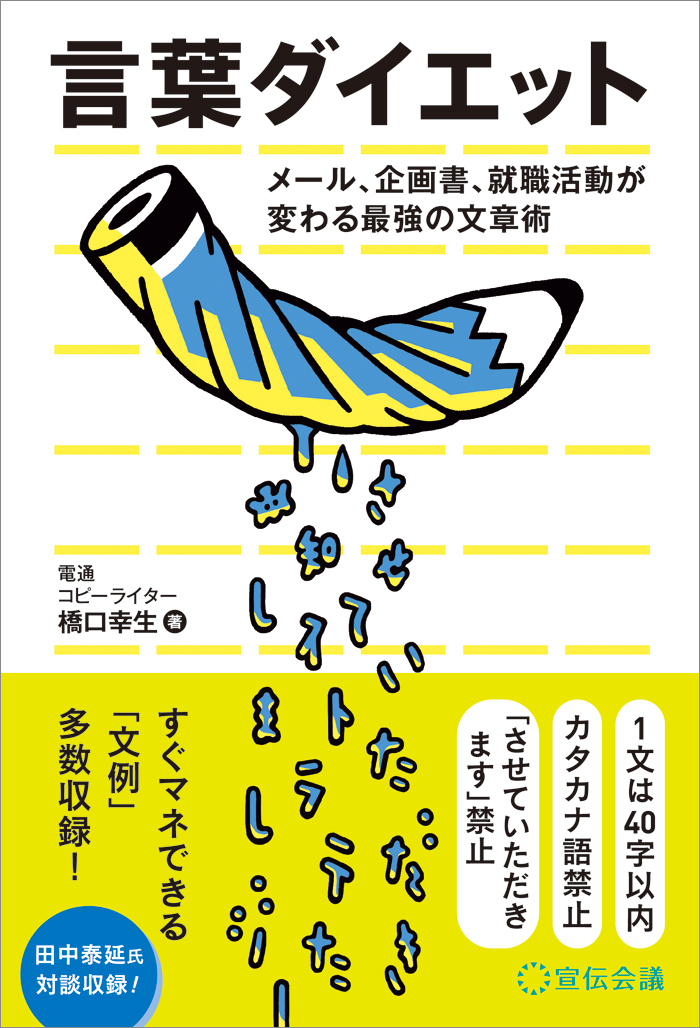Hello, I'm Yukio Hashiguchi, a copywriter. I've just released a book titled 'Word Diet'.
When you visit a bookstore, you'll see the writing techniques section bustling with activity—not just for my book. This likely reflects how many people struggle with the frustration of "writing and writing, yet not being read." Every book in that section meticulously explains various writing techniques designed to get your message across.
Amidst this, as a copywriter, I've been thinking about the "no one reads it" problem from a slightly different perspective.
The reason your writing isn't getting read boils down to just one thing:
You're writing too much.
Just imagine yourself as the reader, and you'll see immediately.
Think about the flood of emails you get every day. There's no way you read every single one word for word, right? Or a proposal packed to the brim with text and arrows. You only skim the key points, right?
In other words, to write something that gets read, the "method of not writing" becomes more important than the "method of writing."
As a copywriter, I approach writing with the same mindset as creating ads. The fundamental premise when making ads is that "no one wants to see the ad." That's precisely why creators employ various strategies to get people who don't want to see it to notice it. They might feature popular celebrities, craft relatable stories—it's where the creator's skill shines. Among these, the most crucial is "narrowing down the message."
What happens if you try to say everything you want: "This product is great here! And great there too!"? Even though ads aren't wanted in the first place, you'll completely turn people off. That's why copywriters select the appeal point most likely to resonate with consumers from among many options and turn it into copy.
This is the absolute foundation, the very first thing new employees at ad agencies learn. For those reading this site, it might seem like "What's the big deal?" I wrote about it specifically because, despite being fundamental, most people forget it the moment it becomes their daily work.
For example, read the following sentence:
In today's Japanese market, where digital transformation is accelerating, the ability to write simple copy that engages a broad demographic is becoming a core competency for all business professionals. The fact that books on such writing techniques are prominently displayed in bookstores across Japan serves as evidence of this trend. However, while these books on conceptual writing techniques can impart frameworks and fundamentals, they often lack a crucial perspective. It was this very gap that prompted me to write this book.
Here's an example of the kind of hard-to-read business writing I might have written myself. To appear up-to-date with industry trends, it spews katakana terms. It becomes convoluted by using unnecessary honorifics. Far from distilling elements, it's a piece of writing bloated with superfluous fat.
Stripping away the waste yields the following text:
The skill of writing readable text is essential in all business. Indeed, bookstores are filled with books on writing techniques. Many are excellent. Yet, they all lack "a certain perspective." This realization was the catalyst for my writing this book.
This is "word dieting." The original text was 271 characters; the revised version is 109 characters. For busy professionals, which is easier to read is obvious, right?
Starting next time, I'll introduce methods for "word dieting" to write shorter, easier-to-read sentences. Short sentences aren't just easier to read; they also have the advantage of being quick to write. I hope this proves useful, even a little, for busy professionals constantly swamped with emails and proposals.
If you can't wait for the next update, please consider purchasing my book. (^_^)



